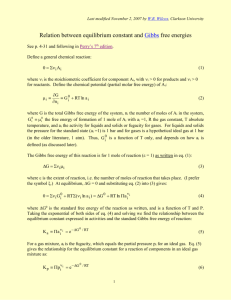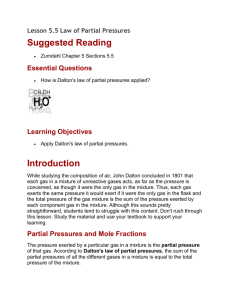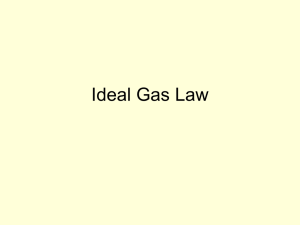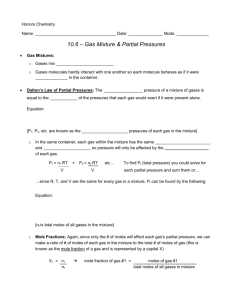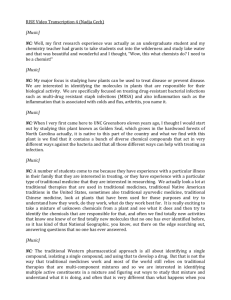GasConstant-PartialPressures-MoleFraction
advertisement
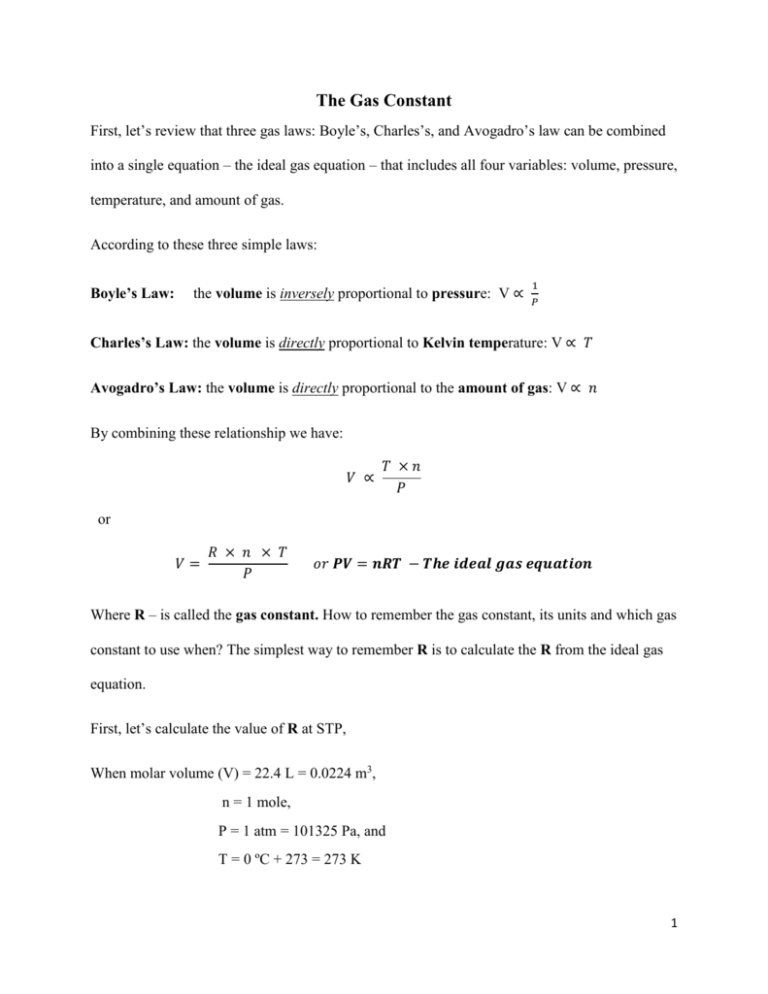
The Gas Constant First, let’s review that three gas laws: Boyle’s, Charles’s, and Avogadro’s law can be combined into a single equation – the ideal gas equation – that includes all four variables: volume, pressure, temperature, and amount of gas. According to these three simple laws: Boyle’s Law: the volume is inversely proportional to pressure: V ∝ 1 𝑃 Charles’s Law: the volume is directly proportional to Kelvin temperature: V ∝ 𝑇 Avogadro’s Law: the volume is directly proportional to the amount of gas: V ∝ 𝑛 By combining these relationship we have: 𝑉 ∝ 𝑇 ×𝑛 𝑃 or 𝑉= 𝑅 × 𝑛 × 𝑇 𝑃 𝑜𝑟 𝑷𝑽 = 𝒏𝑹𝑻 − 𝑻𝒉𝒆 𝒊𝒅𝒆𝒂𝒍 𝒈𝒂𝒔 𝒆𝒒𝒖𝒂𝒕𝒊𝒐𝒏 Where R – is called the gas constant. How to remember the gas constant, its units and which gas constant to use when? The simplest way to remember R is to calculate the R from the ideal gas equation. First, let’s calculate the value of R at STP, When molar volume (V) = 22.4 L = 0.0224 m3, n = 1 mole, P = 1 atm = 101325 Pa, and T = 0 ºC + 273 = 273 K 1 𝑅= 𝑃𝑉 1 𝑎𝑡𝑚 × 22.4 𝐿 𝑳 · 𝒂𝒕𝒎 = = 𝟎. 𝟎𝟖𝟐𝟏 𝑛𝑇 1 𝑚𝑜𝑙 × 273 𝐾 𝒎𝒐𝒍 · 𝑲 Using the SI (Système International d'Unités) units, use m3 for volume and Pa for pressure: 𝑃𝑉 101325 𝑃𝑎 × 0.0224 𝑚3 𝑚3 · 𝑃𝑎 𝐋 · 𝒌𝑷𝒂 𝑅= = = 8.3145 = 𝟖. 𝟑𝟏𝟒𝟓 𝑛𝑇 1 𝑚𝑜𝑙 × 273 𝐾 𝑚𝑜𝑙 · 𝐾 𝒎𝒐𝒍 · 𝑲 𝑚3 · 𝑃𝑎 = 𝐽 (𝑗𝑜𝑢𝑙𝑒) − 𝑡ℎ𝑒 𝑆𝐼 𝑢𝑛𝑖𝑡 𝑜𝑓 𝑒𝑛𝑒𝑟𝑔𝑦, 1 𝐽 = 1 𝐿 · 𝑘𝑃𝑎 Gas Mixtures and Partial Pressures So far we considered the behavior of pure gases – those that consist of only one substance in the gaseous state. How do we deal with gases composed of a mixture of two more different gases? While studying the properties of gases John Dalton observed that the total pressure of a mixture of gases equals the sum of the pressures that each would exert if it were present alone. Imagine three containers of the same volume: 1 – contains gas 1, 2 – contains gas 2, 3 – contains both gases. 2 The pressure exerted by a particular component of a mixture of gases is called the partial pressure of that gas, and Dalton’s observation is known as Dalton’s law of partial pressures. If Pt – is the total pressure of the gas mixture, then the Dalton’s law of partial pressures can be expressed as: Pt = P1 + P2 + P3 + ….. This equation implies that each gas in the mixture behaves independently of the others. Let’s assume that each gas is represented in the mixture in certain amount, and that we can express that amount in the number of moles: n2, n2, n3, ….. and so on. The total number of moles (nt) is equal the sum of number of moles of individual gases. 3 nt = n1 + n2 + n3 + ….. If each of the gases in the mixture obeys the ideal-gas equation, then we can express the pressure for each gas vie that equation: 𝑹𝑻 𝑷𝟏 = 𝒏𝟏 ( 𝑽 PV = n·R·T 𝑹𝑻 ), 𝑷𝟐 = 𝒏𝟐 ( 𝑽 𝑹𝑻 ), 𝑷𝟑 = 𝒏𝟑 ( 𝑽 ) , 𝒂𝒏𝒅 𝒔𝒐 𝒇𝒐𝒓𝒕𝒉, Notice that each of the gases in the mixture occupy the same volume and present at the same temperature. Therefore, substituting partial pressures of gases for the expressions derived from the ideal-gas equation, we obtain: 𝑹𝑻 𝑹𝑻 𝑹𝑻 𝑹𝑻 𝑹𝑻 Pt = 𝒏𝟏 ( 𝑽 ) + 𝒏𝟐 ( 𝑽 ) + 𝒏𝟑 ( 𝑽 ) + … = (n1 + n2 + n3 + …)( 𝑽 ) = 𝒏𝒕 ( 𝑽 ) This equation implies that the total pressure at T = constant and V = constant is determined by the total number of moles of gas present, whether that total represents just one gas or a mixture. Let’s solve one problem: Problem 1. A gaseous mixture made from 6.00 g O2 and 9.00 g CH4 is placed in a 15.0 L vessel at 0 ºC. What is the partial pressure of each gas? What is the total pressure in the vessel? Solution: Let’s analyze first: We need to calculate the pressure for two different gases in the same volume. Plan: Each gas behaves independently from another gas. We can use the ideal-gas equation to calculate the pressure for each gas is the other were not present. First, we need to convert the given amounts of gases into moles. 4 𝑛𝑜𝑥𝑦𝑔𝑒𝑛 = 6.00 𝑔 𝑂2 𝑛𝑚𝑒𝑡ℎ𝑎𝑛𝑒 = 9.00 𝑔 𝐶𝐻4 1 𝑚𝑜𝑙𝑒 𝑂2 = 0.188 𝑚𝑜𝑙𝑒 𝑂2 32.00 𝑔 𝑂2 1 𝑚𝑜𝑙𝑒 𝐶𝐻4 = 0.563 𝑚𝑜𝑙𝑒 𝐶𝐻4 16.04 𝑔 𝐶𝐻4 Second: Now we can use the ideal gas equation to calculate the partial pressure of each gas. 𝑃𝑜𝑥𝑦𝑔𝑒𝑛 𝐿 𝑎𝑡𝑚 0.188 𝑚𝑜𝑙𝑒 𝑂2 × (0.0821 𝐾) 273 𝐾 𝑛𝑜𝑥𝑦𝑔𝑒𝑛 𝑅𝑇 𝑚𝑜𝑙𝑒 = = = 0.281 𝑎𝑡𝑚 (𝑂2 ) 𝑉 15.0 𝐿 𝑃𝑚𝑒𝑡ℎ𝑎𝑛𝑒 = 𝑛𝑚𝑒𝑡ℎ𝑎𝑛𝑒 𝑅𝑇 𝑉 = 0.563 𝑚𝑜𝑙𝑒 𝐶𝐻4 ×(0.0821 15.0 𝐿 𝐿 𝑎𝑡𝑚 𝐾)273 𝐾 𝑚𝑜𝑙𝑒 = 0.841 𝑎𝑡𝑚 (𝐶𝐻4 ) According to Dalton’s law, the total pressure in the vessel is the sum of the partial pressures: 𝑃𝑡 = 𝑃𝑜𝑥𝑦𝑔𝑒𝑛 + 𝑃𝑚𝑒𝑡ℎ𝑎𝑛𝑒 = 0.281 𝑎𝑡𝑚 + 0.841 𝑎𝑡𝑚 = 1.122 𝑎𝑡𝑚 Perform a rough estimation if your answer makes sense. In our case the pressure of roughly 1 atm seems right for the mixture of about 0.2 mol of oxygen and a bit more than 0.5 mole of methane, together in a 15 L vessel, because 1 mole of an ideal gas at 1 atm and 0 ºC occupies about 22 L.º Another problem to practice: What is the total pressure exerted by a mixture of 2.00 g H2 and 8.00 g of N2 at 273 K in a 10.0 L vessel? (2.86 atm). Solution: 𝑛ℎ𝑦𝑑𝑟𝑜𝑔𝑒𝑛 = 2.00 𝑔 𝐻2 1 𝑚𝑜𝑙𝑒 𝐻2 = 0.990 𝑚𝑜𝑙𝑒 𝐻2 2.02 𝑔 𝐻2 𝑛𝑛𝑖𝑡𝑟𝑜𝑔𝑒𝑛 = 8.00 𝑔 𝑁2 1 𝑚𝑜𝑙𝑒 𝑁2 = 0.286 𝑚𝑜𝑙𝑒 𝑁2 28.02 𝑔 𝑁2 5 𝑃𝑡𝑜𝑡𝑎𝑙 𝐿 𝑎𝑡𝑚 𝑛𝑡𝑜𝑡𝑎𝑙 𝑅𝑇 (0.990 𝑚𝑜𝑙𝑒 𝐻2 + 0.286 𝑚𝑜𝑙𝑒 𝑁2 ) × (0.0821 𝑚𝑜𝑙𝑒 𝐾) 273 𝐾 = = 𝑉 10.0 𝐿 = 𝟐. 𝟖𝟔 𝐚𝐭𝐦 One more problem: What is the pressure exerted by a mixture of 1.0 g H2 and 5.00 g He when the mixture is confined to a volume of 5.0 L at 20 ºC? (8.4 atm) Solution: 𝑃𝑡𝑜𝑡𝑎𝑙 = (𝑛ℎ𝑦𝑑𝑟𝑜𝑔𝑒𝑛 + 𝑛ℎ𝑒𝑙𝑖𝑢𝑚 ) × 𝑅𝑇 𝑛𝑡𝑜𝑡𝑎𝑙 𝑅𝑇 = = 𝑉 𝑉 = ((1.00 𝑔 𝐻2 × (0.0821 1 𝑚𝑜𝑙𝑒 𝐻2 1 𝑚𝑜𝑙𝑒 𝐻𝑒 ) + (5.00 𝑔 𝐻𝑒 )) 2.02 𝑔 𝐻2 4.00 𝑔 𝐻𝑒 𝐿 𝑎𝑡𝑚 𝐾) (20 ℃ + 273 𝐾) 𝑚𝑜𝑙𝑒 = 𝟖. 𝟒 𝐚𝐭𝐦 5.0 𝐿 Partial pressure and Mole fractions Now, let’s look at how the mole fraction of a gas is related to its partial pressure. As we just learned, each gas in a mixture behaves independently. Because of that we can relate the amount of a given gas in a mixture to its partial pressure. For an ideal gas: PV = nRT 𝑷= 𝒏𝑹𝑻 𝑽 Therefore, the ratio between the partial pressure of one gas to the total pressure of a mixture will be expressed as: 𝑃1 (𝑛1 𝑅 𝑇)/𝑉 𝑛1 = = 𝑃𝑡 (𝑛𝑡 𝑅 𝑇)/𝑉 𝑛𝑡 6 n1/nt is called the moles fraction of gas 1 which we denote X1 . The mole fraction is a dimensionless number that expresses the ratio of the number of moles of one component to the total number of moles in the mixture. We can rearrange the equation above into: 𝑃1 𝑛1 = = 𝑋1 𝑃𝑡 𝑛𝑡 𝑡ℎ𝑒𝑟𝑒𝑓𝑜𝑟𝑒 𝑃1 = ( 𝑛1 ) 𝑃 = 𝑋1 𝑃𝑡 𝑛𝑡 𝑡 Thus, the partial pressure of a gas in a mixture is its mole fraction times the total pressure. The air we breathe is an excellent example of the gas mixture where each gas is represented in a certain mole fractions. For example, the mole fraction of N2 in air is 0.78 (that means that 78% of the molecules in air are molecules of nitrogen). If the total barometric pressure is 760 torr, then the partial pressure of N2 is: 𝑃𝑁𝑖𝑡 = ( 𝑛1 ) 𝑃 = 𝑋𝑁𝑖𝑡 𝑃𝑡 = (0.78)(760 𝑡𝑜𝑟𝑟) = 𝟓𝟗𝟎 𝒕𝒐𝒓𝒓 𝑛𝑡 𝑡 The result makes sense because nitrogen comprises 78% of the mixture and it contributes 78% of the total pressure. Problem: Air we breathe consists of 20% of oxygen (O2). What is the partial pressure of oxygen if the total pressure is 760 torr? Solution: Since oxygen occupies 20% of the air, the mole fraction of O2 is X oxygen = 0.20. If the total pressure P total = 760 Torr, the partial pressure of oxygen: P oxygen = X oxygen × P total = (0.20)×(760 Torr) = 152 Torr Another problem to practice: A synthetic atmosphere is composed of 1.5 mol percent CO2, 18.0 mole percent O2, and 80.5 percent Ar. 7 a) Calculate the partial pressure of O2 in the mixture if the total pressure of the atmosphere is to be 745 torr. Solution: The mole percent is just the mole fraction times 100. Therefore, the mole fraction of oxygen 𝑋𝑜𝑥𝑦𝑔𝑒𝑛 = 0.180; 𝑃𝑜𝑥𝑦𝑔𝑒𝑛 = 𝑃𝑜𝑥𝑦𝑔𝑒𝑛 × 𝑃𝑡𝑜𝑡𝑎𝑙 = (0.180)(745 𝑇𝑜𝑟𝑟) = 134 𝑇𝑜𝑟𝑟 b) If this atmosphere is to be held in a 120 L space at 295 K, how many moles of O2 are needed? Solution: 𝑃𝑜𝑥𝑦𝑔𝑒𝑛 = 134 𝑇𝑜𝑟𝑟 1 𝑎𝑡𝑚 = 0.176 𝑎𝑡𝑚; 760 𝑇𝑜𝑟𝑟 𝑷𝑽 = 𝒏𝑹𝑻 − 𝑢𝑠𝑒 𝑡ℎ𝑖𝑠 𝑒𝑞𝑢𝑎𝑡𝑖𝑜𝑛 𝑡𝑜 𝑓𝑖𝑛𝑑 𝑛𝑢𝑚𝑏𝑒𝑟 𝑜𝑓 𝑚𝑜𝑙𝑒𝑠 𝑜𝑓 𝑜𝑥𝑦𝑔𝑒𝑛 𝑛𝑜𝑥𝑦𝑔𝑒𝑛 = 𝑃𝑜𝑥𝑦𝑔𝑒𝑛 𝑉 0.176 𝑎𝑡𝑚 × 120 𝐿 = = 𝟎. 𝟖𝟕𝟐 𝒎𝒐𝒍𝒆 𝐿 𝑎𝑡𝑚 𝑅𝑇 0.0821 𝐾 × 295 𝐾 𝑚𝑜𝑙𝑒 8
